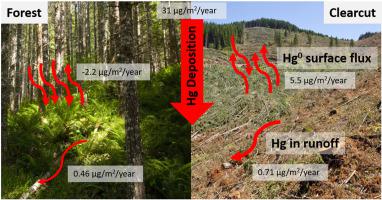Environmental Pollution ( IF 7.6 ) Pub Date : 2021-03-02 , DOI: 10.1016/j.envpol.2021.116869 Chris S Eckley 1 , Collin Eagles-Smith 2 , Michael T Tate 3 , David P Krabbenhoft 3

|
Forest soils are among the world’s largest repositories for long-term accumulation of atmospherically deposited mercury (Hg), and understanding the potential for remobilization through gaseous emissions, aqueous dissolution and runoff, or erosive particulate transport to down-gradient aquatic ecosystems is critically important for projecting ecosystem recovery. Forestry operations, especially clear-cut logging where most of the vegetaiton is removed, can influence Hg mobility/fluxes, foodweb dynamics, and bioaccumulation processes. This paper measured surface-air Hg fluxes from catchments in the Pacific Northwest, USA, to determine if there is a difference between forested and logged catchments. These measurements were conducted as part of a larger project on the impact of forestry operations on Hg cycling which include measurements of water fluxes as well as impacts on biota. Surface-air Hg fluxes were measured using a commonly applied dynamic flux chamber (DFC) method that incorporated diel and seasonal variability in elemental Hg (Hg0) fluxes at multiple forested and harvested catchments. The results showed that the forested ecosystem had depositional Hg0 fluxes throughout most of the year (annual mean: -0.26 ng/m2/h). In contrast, the harvested catchments showed mostly emission of Hg0 (annual mean: 0.63 ng/m2/h). Differences in solar radiation reaching the soil was the primary driver resulting in a shift from net deposition to emission in harvested catchments. The surface-air Hg fluxes were larger than the fluxes to water as runoff and accounted for 97% of the differences in Hg sequestered in forested versus harvested catchments.
中文翻译:

森林和采伐流域的地表空气汞通量和流域质量平衡
森林土壤是世界上最大的大气沉积汞 (Hg) 长期积累的储存库之一,了解通过气体排放、水溶解和径流或侵蚀性颗粒运输到梯度下降的水生生态系统的再迁移潜力对于预测生态系统恢复。林业作业,尤其是砍伐大部分植被的伐木作业,会影响汞的流动性/通量、食物网动态和生物积累过程。本文测量了美国太平洋西北部集水区的地表空气汞通量,以确定森林集水区和伐木集水区之间是否存在差异。这些测量是作为林业作业对汞循环影响的更大项目的一部分进行的,其中包括测量水通量以及对生物群的影响。使用常用的动态通量室 (DFC) 方法测量表面空气汞通量,该方法结合了元素汞 (Hg) 中的日变化和季节变化0 ) 多个森林和采伐流域的通量。结果表明,森林生态系统全年大部分时间都有沉积Hg 0通量(年平均值:-0.26 ng/m 2 /h)。相比之下,收获的集水区主要显示 Hg 0排放(年平均值:0.63 ng/m 2 /h)。到达土壤的太阳辐射差异是导致收获集水区从净沉积转变为排放的主要驱动因素。地表空气汞通量大于作为径流的水通量,占森林与采伐集水区中汞隔离量差异的 97%。











































 京公网安备 11010802027423号
京公网安备 11010802027423号